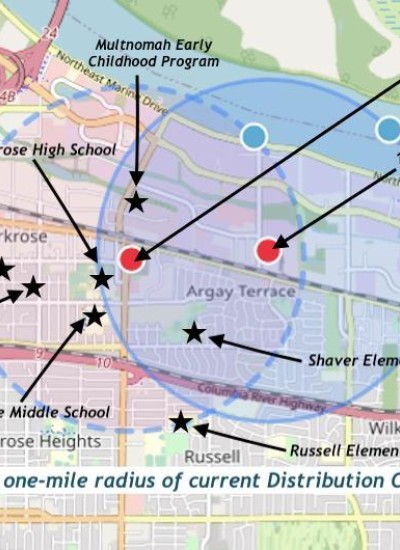By Krystal Eldridge | 5-minute read
Earlier this year, the City of Portland used local code to shut down a Vietnamese restaurant after one neighbor’s odor complaint. The ensuing public uproar – allegations of systemic racism, in particular – caused the city to bring its odor policy under review, with a goal “to see the code changes happen as soon as possible,” according to Commissioner Carmen Rubio.
If that was feasible because of one person who really doesn’t like pho, surely the city can reconsider permits in response to more than 6,500 neighbor complaints about the dangerous health and safety ramifications of building a freight distribution warehouse in a residential neighborhood – especially when that site is across from the most racially diverse public high school in Oregon and sits along a high-crash corridor.
That’s the hope of Parkrose and Argay Terrace neighbors and students, at least.

The site itself has been a magnet for unwanted attention (ahem, ahem), and its derelict state has made those anticipated health concerns a reality before the facility even broke ground. Reasonable observers might conclude the city would want to intervene to create a positive, community-centered space in line with its stated equity plans.
Prologis’s planned logistics center would increase diesel pollution and noise, exacerbate the urban heat island effect that has already made the area among the most vulnerable in Portland, and bring more semi-truck traffic onto streets that students frequent. “Are you thinking of playing sports on the high school fields?” Faith, a Parkrose Middle School student, asks rhetorically in a video. “If this thing goes in, I hope you like coughing when you do,” responds Sarai, a fellow student.
“This ball hasn’t been dropped, because this community cares.” —Lily Burnett, 1000 Friends of Oregon
The facility would also dramatically increase the risk of tragic traffic accidents with children. The current design plan would introduce 37 freight truck bays into this residential area, adding hundreds of daily trips along multiple high-crash corridors where numerous injuries and fatalities have been documented in recent years.
All of this, so far, has been greenlit by city permits.
It seems like everyone with a stake has gotten involved: School district leaders have met with Mayor Ted Wheeler. Neighbors formed the Parkrose Argay Opportunity Coalition and rallied at City Hall. A coalition of advocacy groups, including 1000 Friends, filed a legal challenge to the city permits. And students – perhaps the most active contingent to date – have modeled the sort of galvanizing leadership Gen Z is known for.

“This has been a long fight, almost two years on this specific site. When community members get tired, another one pops up and says, I’ll take the baton. And when the grownups get tired, the students show up and say, Well, we’ll take it now,” says 1000 Friends of Oregon associate director Lily Burnett, who has been part of the community organizing campaign, and whose daughter will eventually attend the Parkrose schools.
“This ball hasn’t been dropped, because this community cares,” she continues. “And also, most people who live here do not have the ability to move somewhere else. If it gets worse and worse, they are here, in it. They cannot afford to move to a different neighborhood of Portland to get away.”

One thing that’s not being taken seriously enough: This is a residential area. Parkrose-Argay might be bisected by 122nd Avenue’s seven transit lanes – five for vehicles and two for bikes – but this axis is surrounded by houses and apartments, representing some of the most racially diverse census tracts in the state. And yet, the former Kmart site in question was rezoned as recently as 2018, three years after the city adopted its equity plans. The new EG2 zoning allows for nearly everything but housing.
Logistics freight warehouses are a necessity, and they have to go somewhere within our urban growth boundaries, but if it wouldn’t be allowed in Laurelhurst or Dunthorpe, why Parkrose and Argay? Why place one inside a neighborhood, on a site that’s well-suited for future housing? In a food desert where a grocery store could fit? Across the street from a school where students say they want a community center – someplace other than Wendy’s where they could go after classes?
“The people in Parkrose-Argay have been disempowered time and again, and right now we have an opportunity to build something truly beneficial for the people who live here, for the Parkrose School District, which has been declining in student population over the last three decades while the City of Portland has put industrial and commercial zones directly abutting residential,” says Burnett.
All eyes are on Prologis and their next step: pouring a concrete foundation, which documents filed with the city indicate could happen as early as May 7. Reaching that stage would indicate Prologis is moving forward without considering concerns the community has raised, especially design changes or any improvements to current plans that could alleviate negative impacts on students, residents, and other future potential of the neighborhood.
“If this warehouse goes in on that site, there will be no further investment in Parkrose,” says Burnett. “There will be no grocery store that will come here. There will be no businesses that come here. There will be no new housing built, because anyone speculating about the future of the neighborhood will be like, Why would I go build housing next to a freight warehouse and an industrial area? I’m not going to be able to sell it for what I want to sell it for,” she continues. “This is really the only ethical use of this site.”
While the City of Portland works on its next move on the land use appeal we co-filed, students have become the all-around most compelling voices in the fight. Neighbors say that they re-energized the campaign when other organizers flagged. “Most of the movement lately has been from students and Parkrose Argay Opportunity Coalition amplifying their voices,” says Annette Stanhope, president of the Parkrose Neighborhood Association.
“Most of the movement lately has been from students and Parkrose Argay Opportunity Coalition amplifying their voices.” —Annette Stanhope, Parkrose Neighborhood Association
When Prologis broke ground, tearing out all the established trees (again, in a heat island), students started making moves. They began a postcard-writing campaign that became a school-wide competition, they held a student action fair, generated press, and have been organizing their peers on YouTube and anywhere else they can take action.
“These are the students,” says Parkrose High School teacher Moé Yonamine, “many who are multigenerational in the Parkrose neighborhood, who really care and want to see a more just and sustainable community that they can live in for years to come.”
